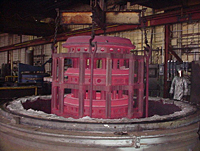Metal Hardening / Metal Quenching / Metal Tempering
(click on thumbnail to enlarge) 
Metal Hardening / Metal Quenching / Metal Tempering
Three large bearing sets being removed from Metlab180" diameter by 156" high carburizing furnace from the hardening temperature (1550°F) for subsequent quenching into agitated, hot oil. Parts were carburized to a case depth in excess of 0.200" ECD. Fixture and component weight is about 40,000 pounds.
Metal Hardening | Metal Quenching | Metal Tempering | Facilities

Metal Hardening
The use of this treatment will result in an improvement of the mechanical properties, as well as an increase in the level of hardness, producing a tougher, more durable item. Alloys are heated above the critical transformation temperature for the material, then cooled rapidly enough to cause the soft initial material to transform to a much harder, stronger structure. Alloys may be air cooled, or cooled by quenching in oil, water, or another liquid, depending upon the amount of alloying elements in the material. Hardened materials are usually tempered or stress relieved to improve their dimensional stability and toughness.
Steel parts often require a heat treatment to obtain improved mechanical properties, such as increasing increase hardness or strength. The hardening process consists of heating the components above the critical (normalizing) temperature, holding at this temperature for one hour per inch of thickness cooling at a rate fast enough to allow the material to transform to a much harder, stronger structure, and then tempering. Steel is essentially an alloy of iron and carbon; other steel alloys have other metal elements in solution. Heating the material above the critical temperature causes carbon and the other elements to go into solid solution. Quenching "freezes" the microstructure, inducing stresses. Parts are subsequently tempered to transform the microstructure, achieve the appropriate hardness and eliminate the stresses.
Metal Quenching
Material is heated up to the suitable temperature and then quenched in water or oil to harden to full hardness according to the kind of steels.
Material is heated to the suitable temperature for hardening, then cooled rapidly by immersing the hot part is water, oil or another suitable liquid to transform the material to a fully hardened structure. Parts which are quenched usually must be aged, tempered or stress relieved to achieve the proper toughness, final hardness and dimensional stability.
Alloys may be air cooled, or cooled by quenching in oil, water, or another liquid, depending upon the amount of alloying elements in the material and final mechanical properties to be achieved. Hardened materials are tempered to improve their dimensional stability and toughness.
Metal Tempering
Tempering is done to develop the required combination of hardness, strength and toughness or to relieve the brittleness of fully hardened steels. Steels are never used in the as quenched condition. The combination of quenching and tempering is important to make tough parts.
This treatment follows a quenching or air cooling operation. Tempering is generally considered effective in relieving stresses induced by quenching in addition to lowering hardness to within a specified range, or meeting certain mechanical property requirements.
Tempering is the process of reheating the steel at a relatively low temperature leading to precipitation and spheroidization of the carbides present in the microstructure. The tempering temperature and times are generally controlled to produce the final properties required of the steel. The result is a component with the appropriate combination of hardness, strength and toughness for the intended application. Tempering is also effective in relieving the stresses induced by quenching.
Facilities
Open or Sealed Furnace - Hardening, Annealing, Normalizing, Solution Treating, etc. up to 2200°F
- Pit Furnace - 144" Diameter by 96" High
- Pit Furnace - 180" Diameter by 156" High
- Pit Furnace (2) - 54" Diameter by 180" High
- Bell Furnaces (4) - 72" Diameter by 84" High
- Integral Oil Quench Furnaces - 24" x 36" x 24" High, 18" x 24" x 18" High
- Rotary Hearth Furnace and Press Quench - Up to 16" Diameter Parts
- Vacuum Furnace - 24" O.D. x 24" Deep

back to top |






 Print This Page
Print This Page

